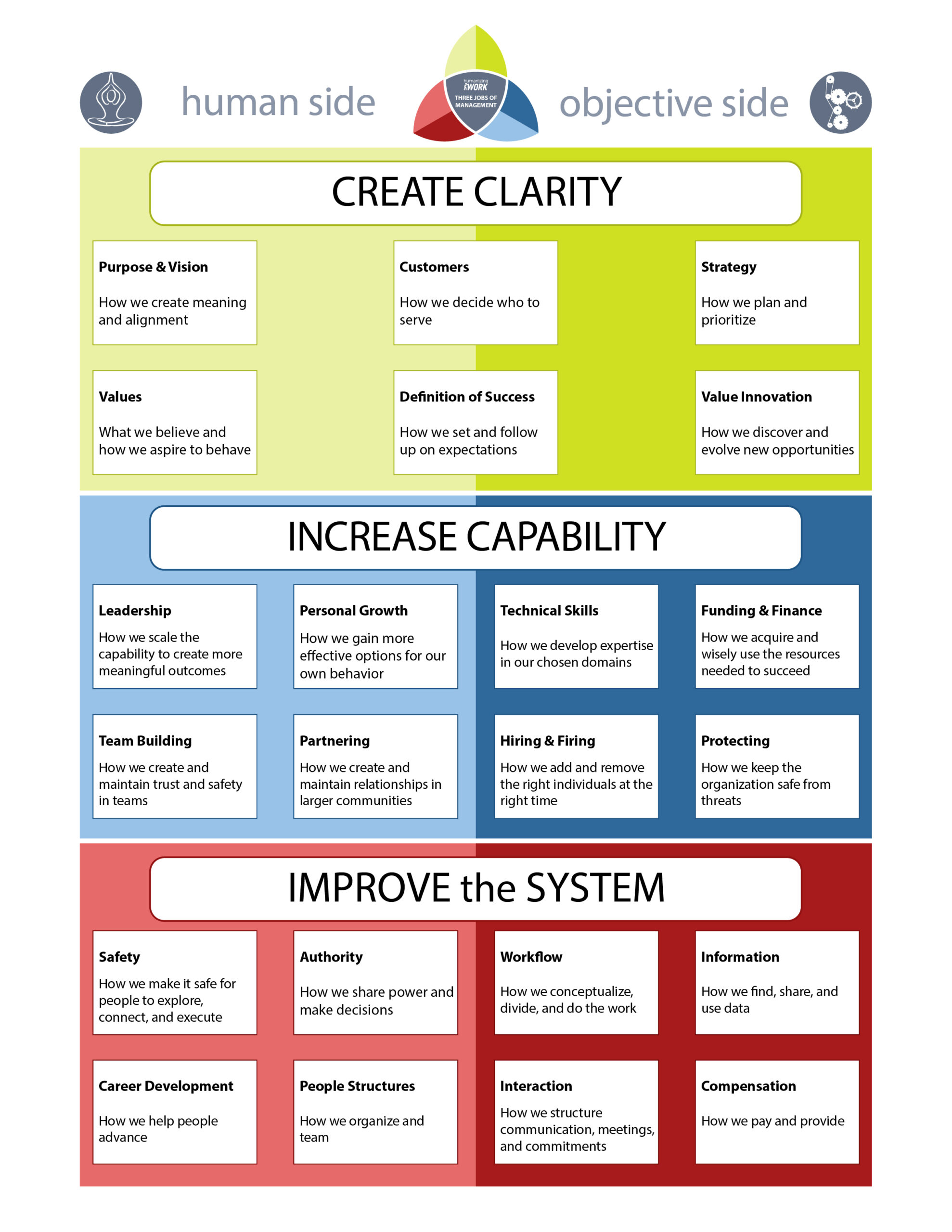If Agile teams are self-organizing, what do the managers do?
Is agile management a thing?
We were managers at successful companies that had adopted Agile, and we wanted to help our teams succeed. Agile had worked great at the team level, and we assumed the agile community had some advice on the role of management. We went looking, but the answers we found were frustrating.
Some were narrow-minded, like “Agile organizations don’t need managers anymore”.
Others were simplistic, like “you don’t need managers, you need leaders!”.
Others were well-intentioned but fuzzy and a bit naive: “just teach your managers to be servant leaders”.
We discovered that we were not alone in finding these answers worse than useless. If this was the best the Agile community could come up with, maybe Agile was more limited than we’d thought.
Finding Answers Beyond the Agile Community
Searching outside of the agile community, we came across some really interesting examples of what looked to us like Agile Management. These companies were using different terminology to describe what they were doing, but we noticed the same patterns as what we see in agile. Some of those organizations were removing traditional management layers, like Morning Star Tomatoes, Geonetric, Valve, and Buurtzorg. But many more were doing very cool things with managers in place, like FAVI under JF Zobrist, the USS Santa Fe under David Marquet, the JSOC under General McChrystal, and Semco under Ricardo Semler. It was becoming clear that having managers in place didn’t necessarily conflict with highly engaged, agile approaches to work.
With those examples in mind, we began working with several of our own clients that wanted to empower teams and who still saw important roles for their managers. Through that work, we discovered that there are really three jobs of management that support and enable self-organizing, high functioning teams. Those three jobs are to Create Clarity, Increase Capability, and Improve the System.
We also discovered that each job has a human side and an objective side. Within each of those broad categories, there are many areas that managers might focus on. Understanding the three jobs with their potential focus areas helped managers get clear on how they could create the environment for their teams to succeed:

Growing Agile Management Skills
When we were promoted to be managers, there was not a lot of training or even clarity about what it meant to do the job well. “You’re successful when your team succeeds” was the general advice we heard.
Our companies offered management training that we found useful, things like how to resolve conflict and how to give feedback. Unfortunately, those workshops typically had a “you’re the boss” viewpoint to them, so while there were some good skills to be picked up, the training often felt old fashioned. Beyond those offerings, what we did to be successful as a manager was a bit haphazard and intuitive. We wish we had had a map like this to aid in our own development as managers!
The three jobs of management model provides an improvement path for any organization. Management does not need to be seen as paper pushers or dead weight. Instead, agile management creates alignment, capability, and flow. We’ve seen two very successful approaches to growing these skills.
Approach 1: Agile Management Series
The Agile Management Series is a set of 3 hour workshops delivered approximately once per month. This approach lets leaders get a consistent, small dose of new content, then a few weeks to practice applying and practicing the new skills.
The first workshop in the series introduces the Three Jobs model, and subsequent workshops teach the skills needed to do those jobs well. Each organization has different needs for their growth, so we customize the series to fit. A few recent client engagements illustrate the different possible paths through the series:

The Agile Management Series help leaders:
- understand the important role they play in an Agile organization
- grow their people’s skills, capabilities, and careers, individually and as teams
- create higher engagement and retention
- amplify agile teams’ capability to deliver value and business results
If you might be interested in customizing this series for your company, please contact us to learn more.
Approach 2: Agile Management Book Club
Many organizations have put together book clubs with a monthly reading assignment and follow up discussions. If you want to set up a book club, we’ve listed below our favorite book in each of the management focus areas within the model. We’re always on the lookout for great new books, so please let us know if you come across one that you think should knock our current #1 recommendations off the list.
Create Clarity
Purpose & Vision | Vivid Vision
Values | Corporate Rebels
Customers | Value Proposition Design
Definition of Success | Radical Focus
Strategy | Good Strategy, Bad Strategy
Value Innovation | Blue Ocean Shift
Increase Capability
Leadership | Scaling Leadership
Team Building | The Five Dysfunctions of a Team
Personal Growth | Mindful Coach |
Partnering | The Lost Art of Connecting
Technical Skills | (Industry Specific)
Hiring | Hiring or Attitude |
Firing | Fire Well
Funding & Finance | Implementing Beyond Budgeting
Protecting | (Looking for Suggestions)
Improve the System
Safety | The Culture Code
Career Development | Who Gets Promoted, Who Doesn’t, and Why
Authority | Turn the Ship Around
People Structures | Reinventing Organizations
Workflow | The Goal
Interaction | Art of Focused Conversation
Information | Cultivating Communities of Practice
Compensation | Scaling Up Compensation